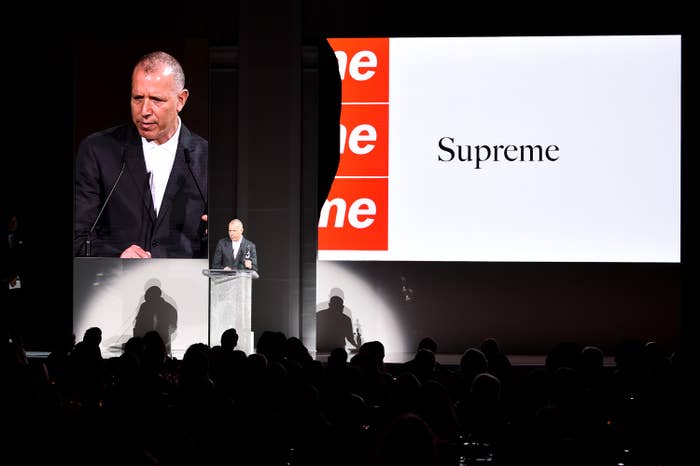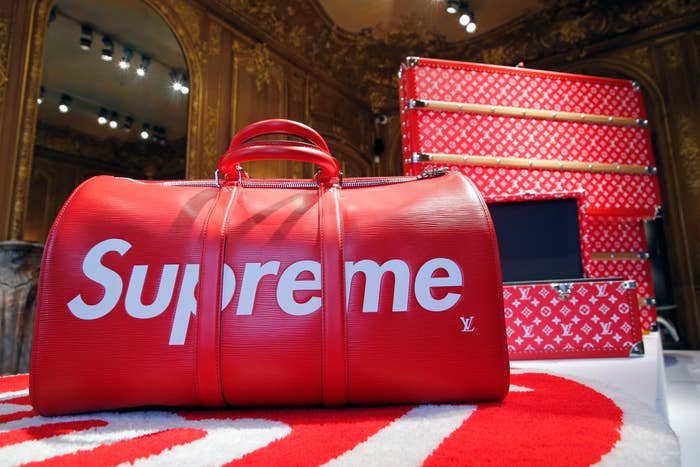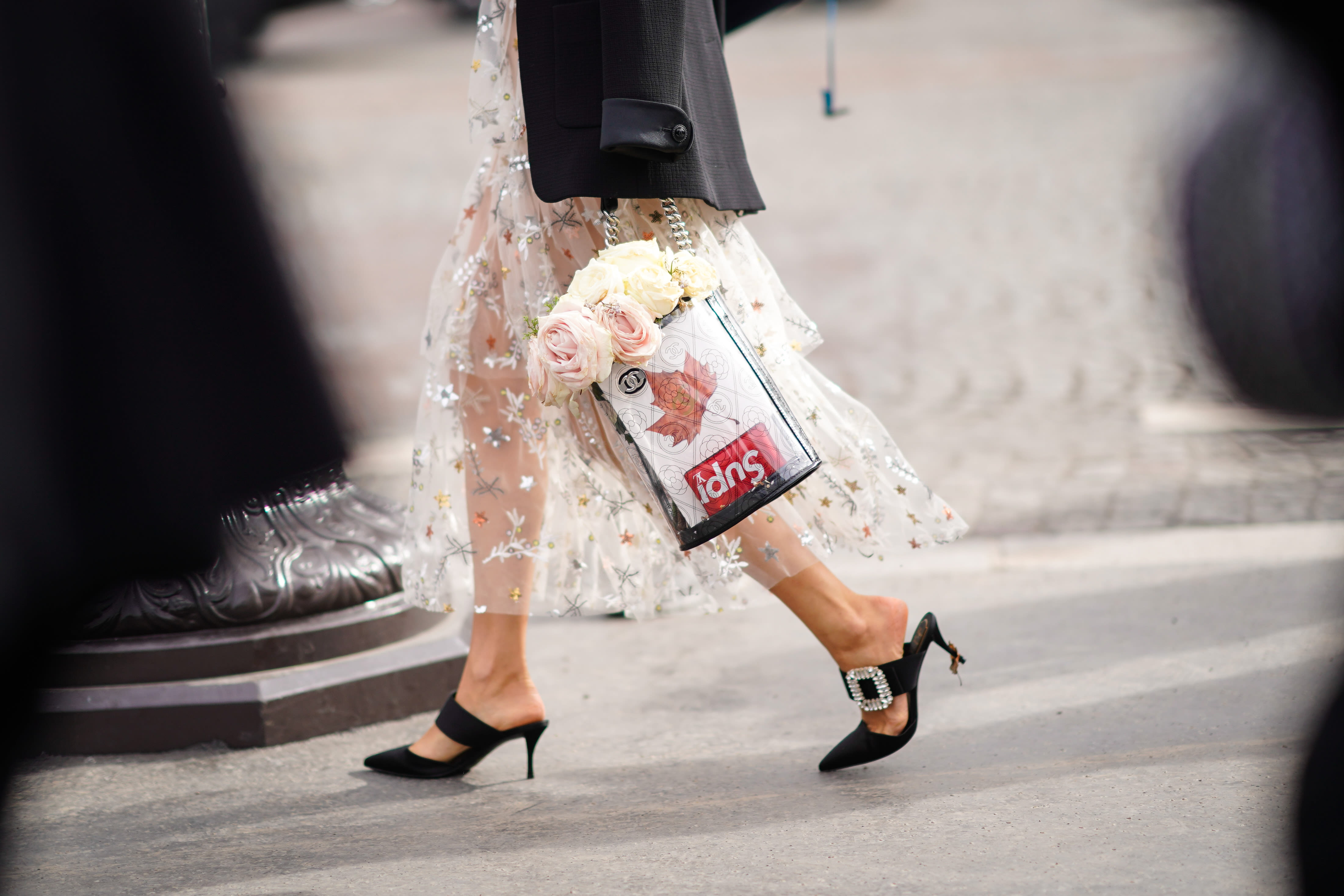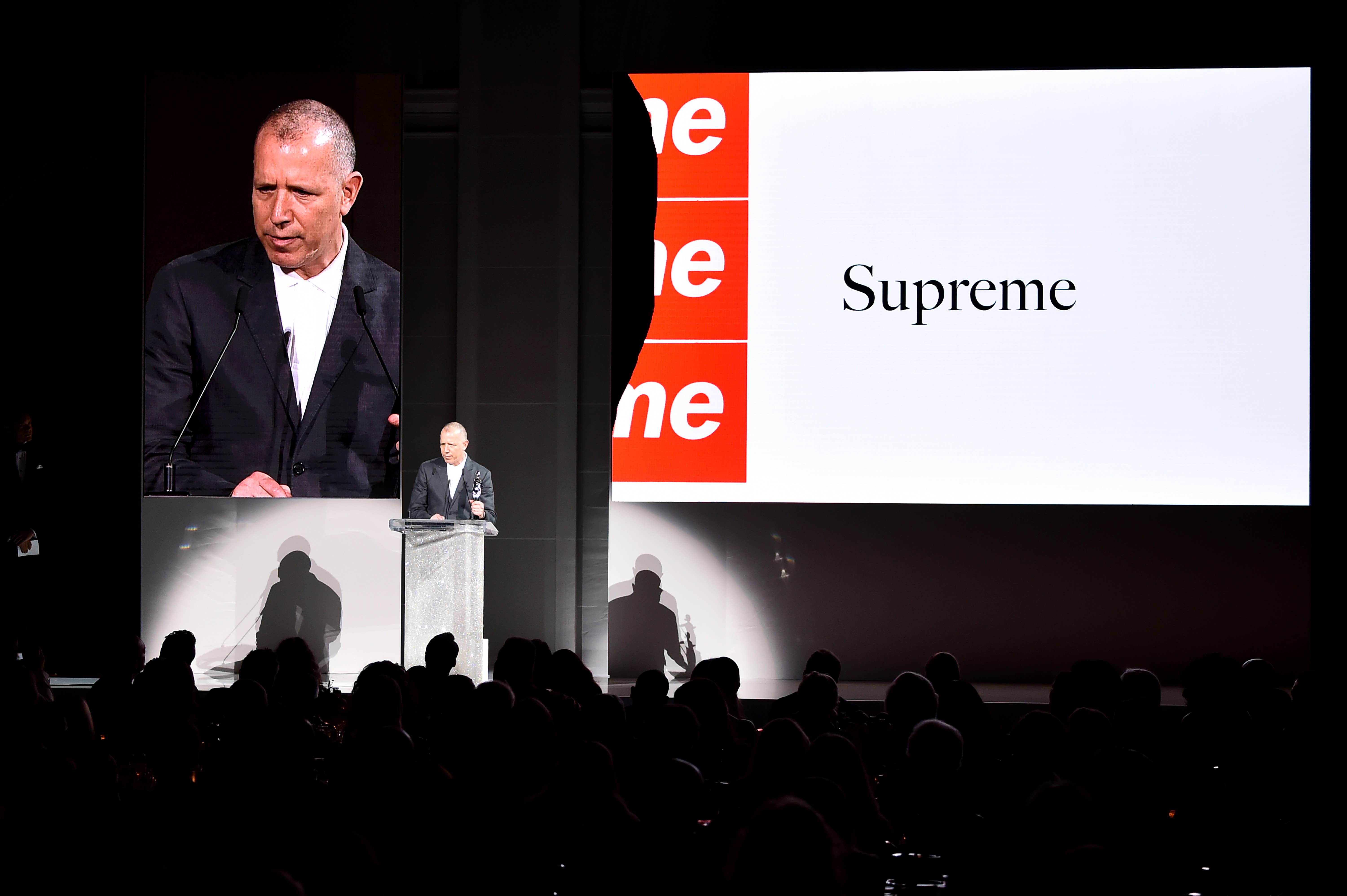
In the March 1995 issue of Vogue, the fashion magazine ran an article, titled “The rules of attraction,” which was later included in Rizzoli's Supreme coffee table book. In the piece, writer Mary Tannen compared Chanel—a then 86-year-old luxury fashion house—to Supreme—a New York underground skate label that was just a year-old at the time. Tannen, who visited both Supreme’s Lafayette Street flagship and Chanel’s East 57th Street boutique, argued that while both brands operated in different circles, they actually were more similar than one might’ve thought. She drew parallels between their cult-like followings, the atmosphere and features of the stores (both had videos playing on screens), and the importance of each brand’s logo to its loyal fanbase. “A few miles and worlds apart, yet at the core of what they are and what they mean to their devotees, they are deeply, fundamentally the same,” she wrote.
When I first saw the Vogue article in the Supreme hardcover when it was released in 2010, I remember being surprised and amused at what read as fashion’s belated acceptance of streetwear, but also a little perplexed. At the time I read the article, streetwear’s popularity had ballooned. Guys like Nick Diamond and Bobby Hundreds were making serious money off their respective brands, Diamond Supply Co. and The Hundreds. Supreme was already drawing long lines at both its New York and Fairfax Avenue flagships and celebrities like Pharrell and Kanye West had been spotted wearing brands like A Bathing Ape. Prior to this surge, the fashion industry had paid little to no attention to streetwear and high-fashion magazines like Vogue certainly weren’t writing about it. Looking back now— especially knowing that the magazine would go on to ignore streetwear in the years that followed—the positive comparisons Vogue drew between Supreme and Chanel read as deeply ironic.
Last night, I couldn’t help but think of that very article. During the Council of Fashion Designers of America (CFDA) Awards at the Brooklyn Museum, Supreme won the prestigious Menswear Designer of the Year award. Dressed in a gray suit, James Jebbia, the brand’s founder, accepted the statuette. “I’ve never considered Supreme to be a fashion company or myself a designer,” he said, “but I appreciate your recognition for all we do.”

Jebbia and Supreme beat out Virgil Abloh, Tom Ford, Thom Browne, and Raf Simons for Calvin Klein—all of whom, save for Abloh, have won the award before (Simons in 2017, Brown in 2016, and Ford in 2008, 2013, and 2015). Before streetwear became mainstream in the last year or so, high-fashion had definitively turned their nose up at streetwear. Now, Supreme is CFDA’s Menswear Designer of the Year. While the award was a major triumph for Supreme (and streetwear), the honor reads as ingenuine.
Supreme’s victory made headlines this morning, but it’s also drawn criticism. Many have argued that Supreme and Jebbia are not designers in the traditional sense that Ford, Browne, and Simons are. Vanessa Friedman, fashion director and chief fashion critic for The New York Times, called Supreme’s triumph “the biggest upset of the night.” (The other “upset,” some felt, was Kim Kardashian’s Influencer Award win.)
While I don’t agree that Jebbia is a better menswear designer than Ford, Browne, and Simons—skilled individuals who’ve presented original, forward-thinking designs that have impacted fashion over the years—I can’t say I was surprised Supreme nabbed the prize. The brand has had a monstrous run over the last two years. In 2017, its highly-anticipated collaboration with Louis Vuitton was released, marking the first time a luxury house had lent its expertise to a streetwear brand. The collection has often been described by industry experts as the brand’s “fashion consecration,” a move that introduced Supreme to a wider audience. A testament to this fact: I once overheard a 60-something-year-old woman dressed in head-to-toe Gucci argue with a Dover Street Market sales employee about why he couldn’t set aside pieces for her from the collab. Louis Vuitton, she said, had often done this for her.

In October 2017, it was revealed that the Carlyle Group had paid a reported $500 million for a 50 percent stake in Supreme, valuing the business at roughly $1 billion. More recently, this year’s insanely hyped Supreme x Rimowa collab—much like many of Supreme’s releases—swiftly disappeared from shelves. According to Rimowa co-chief executive, Alexandre Arnault, the suitcases sold out in 34 seconds.
Much of what has been said and written about Supreme’s win has pointed to the way we define designers and the state of the fashion industry today. In 2018, technical skills and experience are less vital; what’s more valuable is an understanding of what people want to buy and how they want to buy it. Designers like Virgil Abloh (high-fashion’s current obsession), Jerry Lorenzo, John Elliott, and Ronnie Fieg mark a new generation of designers who don't have formal training, but have found their footing in fashion. Also, consider Gucci’s and Balenciaga’s successes: both brands have cracked the code with millennials, a generation that’s been particularly troubling for luxury brands, and are now the top label and fastest growing label, respectively, at parent company Kering.
“The Awards should reflect the times,” Steven Kolb, President and CEO of the CFDA, said after the nominees were announced back in March. “Having James and Virgil, two exciting talents, nominated reflects the crossroads of change that is happening in our industry. CFDA is proud that the members of our Awards Nominating Guild recognized that creativity is no longer just defined by traditional models of business, and were modern in their thinking.”
Consider where streetwear is today, and Supreme’s role in that. In the last few years, the once underground subculture has been propelled into the mainstream, a turn sparked partly by the rise of luxury streetwear. Now, retailers like Bergdorf Goodman and Barneys sell streetwear. Barneys is even mimicking the culture’s approach to releases with events like thedrop@barneys (in partnership with Highsnobiety), which included collaborations with many of the key figures in the streetwear world, including Abloh, Heron Preston, Lorenzo, and more.

Within that shift, Supreme emerged as the most popular and mainstream streetwear brand. As a result of that success, it also became the entry-point for those looking to learn more about the culture, the way Drake often is for rap—a fact that’s driven some original fans away from the brand. While Supreme has never actively sought out to participate in the fashion space the way someone like Abloh has, it’s become the one streetwear label that high-fashion has truly accepted, paid attention to, collaborated with, and whose business model and drop system it regularly plucks from. So, at a time when streetwear has heavily impacted and influenced the industry, it’s not so far-fetched that Supreme notched the win.
Still, one can’t help but wonder how authentic this recognition of Supreme (and streetwear) really is. Was this just the CFDA’s attempt to be relevant? Was this another ploy by the high fashion industry to capture a younger audience as many brands, like LVMH, have? In a way, it’s the same criticism surrounding Kendrick Lamar’s Pulitzer Prize in music. Lamar’s album DAMN was a masterpiece, but when Pulitzer administrator Dana Canedy said the album “shines a light on hip-hop,” one had to wonder if the Pulitzers were pandering to youth culture. As with the CFDAs, it seems the old-fashioned gatekeepers were mostly concerned with creating a bigger moment for themselves.

